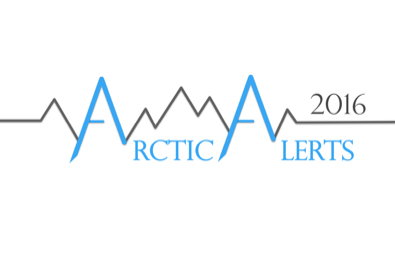 When: July 13, 2016 / 1:00 – 3:00 pm
When: July 13, 2016 / 1:00 – 3:00 pm
Where: The National Press Club, 529 14th Street NW, Washington, DC![]() Arctic Alerts 2016 Media Kit
Arctic Alerts 2016 Media Kit
So far, 2016 is revealing unprecedented changes in the Arctic environment. Over the past 120 years, as greenhouse gases accumulated in the Earth’s atmosphere, the global average temperature increased by 1.4°F. In Alaska and throughout the Arctic, however, the increase was twice the global average. The Arctic’s diminishing sea ice, thawing permafrost, and melting ice sheets and glaciers are amplifying both regional and global climate warming, as well as intensifying the impacts. Records in air temperature, ice melt, spring snow cover loss, and extreme weather events are interconnected. Current observations of rapid Arctic environmental change continue to illuminate these connections and their societal implications. SEARCH advances and communicates scientific understanding to help society respond to a rapidly changing Arctic. In this media roundtable, SEARCH highlights recent rapid changes in the Arctic that have global implications.
Event Agenda
1:00 – 1:30 pm EDT:
- Introductions - Brendan P. Kelly, Executive Director, SEARCH
- Diminishing Arctic sea ice; local and global consequences- Walt Meier (NASA)
- Northern Hemisphere snow cover; trends and implications - Dave Robinson (Rutgers University)
- Melting ice sheets and rising sea levels - Marco Tedesco (Columbia University)
- Thawing permafrost and global climate- Ted Schuur (Northern Arizona University)
- Atmospheric response to a warming Arctic- Jennifer Francis (Rutgers University)
1:30 – 3:00 pm EDT: Questions and discussion
3:00 – 4:30 pm EDT: Additional press availability (First Amendment Lounge)
Key Observations
- The loss, in recent decades, of thousands of square miles of sea ice has accelerated warming in the Arctic, where temperatures are increasing at two to three times the rate of the globe as a whole.
- The rapid warming in the Arctic, in turn, is melting ice sheets and glaciers, contributing 1 mm to an overall 3 mm annual rise in sea level.
- Melt of the Greenland ice sheet is further enhanced by a prolonged inflow of warm, moist air traced back to Arctic sea ice loss.
- Current rates of warming could be amplified by release of an estimated 130-‐160 billion tons of carbon from thawing permafrost during this century.
- Extensive reductions in sea ice are disrupting the Arctic marine ecosystem, threatening species important to the economies and cultures of Arctic peoples.
- Beyond Alaska, the warming Arctic affects other states through sea level rise and extreme weather; evidence is accumulating that Arctic warming will contribute to increases in droughts, heat waves, fire seasons, stormy winters, and flooding across the United States.
State of the Science Briefs
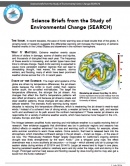
![]() SEARCH Science Brief: Climate Change and the Permafrost Carbon Feedback
SEARCH Science Brief: Climate Change and the Permafrost Carbon Feedback![]() SEARCH Science Brief: A Warming Arctic Threatens Rural Community Resilience
SEARCH Science Brief: A Warming Arctic Threatens Rural Community Resilience![]() SEARCH Science Brief: Effects of the Arctic Meltdown on U.S. Weather Patterns
SEARCH Science Brief: Effects of the Arctic Meltdown on U.S. Weather Patterns![]() SEARCH Science Brief: Rapid Arctic Environmental Change Disrupts Marine Ecosystems
SEARCH Science Brief: Rapid Arctic Environmental Change Disrupts Marine Ecosystems![]() SEARCH Science Brief: Disappearing Sea Ice Fuels Greenland Melt
SEARCH Science Brief: Disappearing Sea Ice Fuels Greenland Melt![]() SEARCH Science Brief: Diminishing Arctic Sea Ice
SEARCH Science Brief: Diminishing Arctic Sea Ice![]() SEARCH Science Brief: Arctic Land Ice is Decreasing
SEARCH Science Brief: Arctic Land Ice is Decreasing
Presentation Slides & Summaries
![]() Arctic Alerts 2016 Presentation Slides
Arctic Alerts 2016 Presentation Slides
Introduction
The Arctic is changing in ways not evident in thousands of years, and we are challenged to keep up with the changes and understand how they are interconnected. We do not know exactly where this “new Arctic” will end up, but we already see increasingly dramatic impacts of its rapid change both within and outside the Arctic. Accustomed to advancing our disciplines at what is often called a ‘glacial’ pace, we recognize that glaciers are not so slow anymore. They are accelerating and—to serve society—our science needs to accelerate as well. SEARCH scientists are committed to doing our part to make our discoveries accessible to everyone.
Diminishing Arctic sea ice
Sea ice, the ice floating in the ocean, is an important component of the Arctic climate system. It modulates the amount of solar energy absorbed during the continuous daylight of summer and it acts as a physical barrier limiting the interaction of the ocean and the atmosphere. Over the past three and a half decades, sea ice has declined significantly, particularly during summer. This year reinforces that long-‐term decline with record low area coverage in 5 of the first 6 months of 2016. The ice has also thinned in recent years and this thinner ice is more responsive to atmospheric circulation. This year stronger than normal, but not extreme, winds have caused the extreme ice loss because the thinner ice is more easily moved around by the winds, opening up areas of water much earlier in the spring. These areas of open water influence: (1) the land by allowing more ocean waves and more coastal erosion, (2) Greenland outlet glaciers by exposing the glacier fronts to warmer ocean waters, and (3) the atmosphere by providing a source of heat and moisture during autumn.
Melting ice sheets and sea level rise
The Greenland ice sheet plays a crucial role in the Arctic and global climate systems through its impact and feedbacks on radiative budget, ocean, atmosphere and ecosystems. Over the past decade, Greenland has contributed to sea level rise at an average rate of ~ 270 Gt/year, with a peak up to ~ 640 Gt during the extreme year of 2012. Currently, surface melting is the major accelerating contribution to sea level rise from Greenland. According to satellite data and models, over the past 30 years melt extent has been increasing at an average rate of 3.5 %/decade and occurring at higher elevations and for longer periods. In 2016, melting in Greenland started early, a few days before the record-‐setting date of 2012, and is above average through early July 2016. Surface temperatures in Greenland also set new records for the period of March to July in 2016. Surface melting is currently at its peak, with 2016 positioning itself already among the top melting years. Whether a new record will be set depends on how melting will evolve over the next few weeks.
Declining spring snow cover extent over Northern Hemisphere lands
The physical characteristics of a snow-‐covered landscape, including its influence on surface reflectance, result in snow playing a critical role in the Arctic climate system. Snow extent is an important climate variable to monitor when assessing climate change, as it is closely associated with temperature, moisture and atmospheric circulation, as well as with other cryospheric variables. Snow cover, or the lack thereof, is of considerable importance for decision makers in transportation, hunting and other sectors of Arctic economies. A 50-‐year climate data record of satellite-‐monitored snow cover identifies declining spring extent over Northern Hemisphere lands. This is exemplified by record minimum extent averaged from March through June 2016. Over the satellite era, the rate of spring snow loss is similar to that of late-‐summer Arctic sea ice extent, with each at an accelerated pace over the past decade.
Thawing permafrost and its impact on global climate
There are at least ~1500 billion tons of organic carbon in permafrost zone soils, almost twice as much as currently exists in the atmosphere. Thawing permafrost likely will emit greenhouse gases—primarily carbon dioxide—in volumes similar to emissions from other environmental changes, such as deforestation. Globally, permafrost carbon emissions are likely to amplify warming caused by fossil fuel burning and other human activities. Locally, thawing will degrade infrastructure and ecosystem services.
Atmospheric response to a warming Arctic
As the Arctic undergoes rapid change, it is clear that the atmosphere is playing important roles in driving the change, as well as responding to it. Local responses are well understood, but the ways in which amplified Arctic warming is affecting mid-‐latitude weather patterns are still emerging. In 2016, record-‐breaking ice and snow loss is clearly linked with record warm air temperatures, and evidence suggests the Arctic meltdown is also contributing to extreme weather events around the Northern Hemisphere.
Presenters
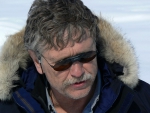 Brendan P. Kelly is Executive Director of the Study of Environmental Arctic Change (SEARCH) and Research Professor at the International Arctic Research Center, University of Alaska Fairbanks. A marine ecologist with a focus on sea ice environments, he has participated in and led collaborative research in the North Pacific Ocean, the Arctic Ocean, the Sea of Okhotsk, the Baltic Sea, and Antarctica. He has served as Deputy Director for Arctic Sciences, National Science Foundation; Assistant Director for Polar Science in the White House Office of Science and Technology Policy; and as a science adviser to indigenous organizations in Alaska. Currently, he serves on the National Academy of Sciences’ Polar Research Board and as a Senior Fellow at the Center for the Blue Economy, Middlebury Institute of International Studies at Monterey. Dr. Kelly received degrees in Biology from the University of California Santa Cruz (B.A.), the University of Alaska Fairbanks (M.S.), and Purdue University (Ph.D.). Contact: bpkelly [at] alaska.edu; 907-209-6531.
Brendan P. Kelly is Executive Director of the Study of Environmental Arctic Change (SEARCH) and Research Professor at the International Arctic Research Center, University of Alaska Fairbanks. A marine ecologist with a focus on sea ice environments, he has participated in and led collaborative research in the North Pacific Ocean, the Arctic Ocean, the Sea of Okhotsk, the Baltic Sea, and Antarctica. He has served as Deputy Director for Arctic Sciences, National Science Foundation; Assistant Director for Polar Science in the White House Office of Science and Technology Policy; and as a science adviser to indigenous organizations in Alaska. Currently, he serves on the National Academy of Sciences’ Polar Research Board and as a Senior Fellow at the Center for the Blue Economy, Middlebury Institute of International Studies at Monterey. Dr. Kelly received degrees in Biology from the University of California Santa Cruz (B.A.), the University of Alaska Fairbanks (M.S.), and Purdue University (Ph.D.). Contact: bpkelly [at] alaska.edu; 907-209-6531.
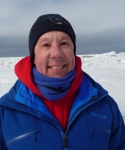 Walt Meier is a research scientist in the Cryospheric Sciences Lab at the NASA Goddard Space Flight Center. His research focuses on remote sensing of sea ice, developing new sea ice products and sea ice climate data records, and analyzing changes in the Arctic sea ice cover. Walt was a coordinating lead author for the Arctic Council's "Snow, Water, Ice, and Permafrost in the Arctic (SWIPA) Assessment Report", published in Fall 2011, and is a lead author of the follow-up report to be published next year. He has served on numerous international and national committees on sea ice, Arctic climate, and climate data. He has a B.S. from the University of Michigan and an M.S. and Ph.D. from the University of Colorado. Before joining NASA Goddard in 2013, Walt was a visiting scientist at the U.S. National Ice Center from 1999 to 2001, an adjunct assistant professor at the U.S. Naval Academy from 2001 to 2003, and a research scientist at the National Snow and Ice Data Center from 2003 to 2013. Contact: walt.meier [at] nasa.gov; 301‐614‐6572.
Walt Meier is a research scientist in the Cryospheric Sciences Lab at the NASA Goddard Space Flight Center. His research focuses on remote sensing of sea ice, developing new sea ice products and sea ice climate data records, and analyzing changes in the Arctic sea ice cover. Walt was a coordinating lead author for the Arctic Council's "Snow, Water, Ice, and Permafrost in the Arctic (SWIPA) Assessment Report", published in Fall 2011, and is a lead author of the follow-up report to be published next year. He has served on numerous international and national committees on sea ice, Arctic climate, and climate data. He has a B.S. from the University of Michigan and an M.S. and Ph.D. from the University of Colorado. Before joining NASA Goddard in 2013, Walt was a visiting scientist at the U.S. National Ice Center from 1999 to 2001, an adjunct assistant professor at the U.S. Naval Academy from 2001 to 2003, and a research scientist at the National Snow and Ice Data Center from 2003 to 2013. Contact: walt.meier [at] nasa.gov; 301‐614‐6572.
 Marco Tedesco is Lamont Research Professor at the Lamont-Doherty Earth Observatory of the Columbia University in New York City. He is a cryosphere scientist investigating snow and ice in Earth’s climate system using in-situ observations, remote sensing data and regional climate models. He has been Research Assistant and associate at the NASA Goddard Space Flight Center and Associate Professor at the Earth and Atmospheric Sciences Dept. of the City College of New York before joining Columbia University. Dr. Tedesco also served as Program Director at the National Science Foundation (Office of Polar Programs) between September 2012 and June 2015. Dr.Tedesco received his ‘Laurea’ degree in Electrical Engineering from the University of Naples, Italy, his Ph.D. in Enviromental Engineering from the Institute of Applied Physics ‘Carrara’ in Florence, Italy. Contact: mtedesco [at] ldeo.columbia.edu; 202‐375-4884.
Marco Tedesco is Lamont Research Professor at the Lamont-Doherty Earth Observatory of the Columbia University in New York City. He is a cryosphere scientist investigating snow and ice in Earth’s climate system using in-situ observations, remote sensing data and regional climate models. He has been Research Assistant and associate at the NASA Goddard Space Flight Center and Associate Professor at the Earth and Atmospheric Sciences Dept. of the City College of New York before joining Columbia University. Dr. Tedesco also served as Program Director at the National Science Foundation (Office of Polar Programs) between September 2012 and June 2015. Dr.Tedesco received his ‘Laurea’ degree in Electrical Engineering from the University of Naples, Italy, his Ph.D. in Enviromental Engineering from the Institute of Applied Physics ‘Carrara’ in Florence, Italy. Contact: mtedesco [at] ldeo.columbia.edu; 202‐375-4884.
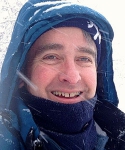 David Robinson is a Professor of Geography at Rutgers University, where his primary research interests run the spatial gamut from global to local, with an underlying theme being the development of a better understanding of the climate system. The majority of his published research has focused on hemispheric and regional snow cover dynamics and interactions of snow cover with other climate elements. This includes maintaining an internationally-recognized database of Northern Hemisphere snow extent throughout the satellite era: http://snowcover.org. As the New Jersey State Climatologist, he conducts research of an applied nature that focuses on the diverse weather and climate of the Garden State. This includes topics such as climate change, drought, flooding, and issues involving agriculture, transportation, public safety and commerce. Contact: david.robinson [at] rutgers.edu.
David Robinson is a Professor of Geography at Rutgers University, where his primary research interests run the spatial gamut from global to local, with an underlying theme being the development of a better understanding of the climate system. The majority of his published research has focused on hemispheric and regional snow cover dynamics and interactions of snow cover with other climate elements. This includes maintaining an internationally-recognized database of Northern Hemisphere snow extent throughout the satellite era: http://snowcover.org. As the New Jersey State Climatologist, he conducts research of an applied nature that focuses on the diverse weather and climate of the Garden State. This includes topics such as climate change, drought, flooding, and issues involving agriculture, transportation, public safety and commerce. Contact: david.robinson [at] rutgers.edu.
 Ted Schuur is a Professor in the Center for Ecosystem Science and Society at Northern Arizona University. One of his major research interests is to understand feedbacks to climate change from warming temperatures, permafrost thaw, and changing fire regimes in boreal and arctic ecosystems. His work on this topic has included almost two decades of field research, and in this time has resulted in more than 100 peer-reviewed publications in high profile journals such as Science, Nature, and the Proceeding of the National Academy of Sciences. He is the also the lead investigator for the Permafrost Carbon Network, an international consortium of researchers aimed at synthesizing new knowledge on this topic. He graduated Magna Cum Laude with a BS from the University of Michigan. He received a PhD from the University of California-Berkeley and held a NSF Postdoctoral Fellowship at the University of California-Irvine, and spent 12 years on the faculty of the University of Florida. Contact: ted.schuur [at] nau.edu; 352-275-1869.
Ted Schuur is a Professor in the Center for Ecosystem Science and Society at Northern Arizona University. One of his major research interests is to understand feedbacks to climate change from warming temperatures, permafrost thaw, and changing fire regimes in boreal and arctic ecosystems. His work on this topic has included almost two decades of field research, and in this time has resulted in more than 100 peer-reviewed publications in high profile journals such as Science, Nature, and the Proceeding of the National Academy of Sciences. He is the also the lead investigator for the Permafrost Carbon Network, an international consortium of researchers aimed at synthesizing new knowledge on this topic. He graduated Magna Cum Laude with a BS from the University of Michigan. He received a PhD from the University of California-Berkeley and held a NSF Postdoctoral Fellowship at the University of California-Irvine, and spent 12 years on the faculty of the University of Florida. Contact: ted.schuur [at] nau.edu; 352-275-1869.
Jennifer Francis earned a B.S. in Meteorology from San Jose State University in 1988 and a PhD in Atmospheric Sciences from the University of Washington in 1994. As a professor at Rutgers University since 1994, she has taught courses in satellite remote sensing and climate-change issues, and also cofounded and codirected the Rutgers Climate and Environmental Change Initiative. Presently, she is a Research Professor in the Rutgers Department of Marine and Coastal Sciences, and she studies Arctic climate change and Arctic-global climate linkages. She and her husband circumnavigated the world in a sailboat from 1980-1985, including Cape Horn and the Arctic, during which her interest in weather and the Arctic began. Contact: francis [at] imcs.rutgers.edu.
Additional Resources
- The Arctic in the Anthropocene: Emerging Research Questions
- Arctic Matters: The Global Connection to Changes in the Arctic
- Arctic Research Consortium of the United States
- Arctic Update, United State Arctic Research Consortium
- Global Snow Lab, Rutgers University
- Interagency Arctic Research Policy Committee
- International Arctic Research Center, University of Alaska Fairbanks
- National Snow and Ice Data Center
- National Strategy for the Arctic Region
- NOAA Arctic Report Card
- Polar Programs, National Science Foundation
- Polar Research Board, National Academy of Sciences
- Sea Ice Prediction Network
Sponsors
Arctic Alerts 2016 is sponsored by:
The Study of Environmental Arctic Change (SEARCH) facilitates collaboration between Arctic researchers, funding agencies, and other stakeholders so that science can inform societal responses to Arctic change. With participants representing over one dozen academic and governmental research institutions, SEARCH focuses on how retreating sea ice, thawing permafrost, and diminishing land ice are impacting society within and beyond the Arctic. Emphasizing “knowledge to action”, SEARCH promotes original and collaborative research, synthesizes research findings, and broadly communicates the resulting knowledge to Arctic stakeholders, policy-makers, and the public. SEARCH is funded by the National Science Foundation with additional support from the National Center for Atmospheric Research, the University of Alaska Fairbanks, the Center for the Blue Economy (Middlebury Institute of International Studies at Monterey), the U.S. Geological Survey, NOAA, NASA, and the U.S. Arctic Research Commission. https://www.arcus.org/search-program/vision
The University of Alaska Fairbanks (UAF) is a Land, Sea, and Space Grant university and an international center for research, education, and the arts, emphasizing the circumpolar North and its diverse peoples. UAF integrates teaching, research, and public service as it educates students for active citizenship and prepares them for lifelong
learning and careers. https://www.uaf.edu/
